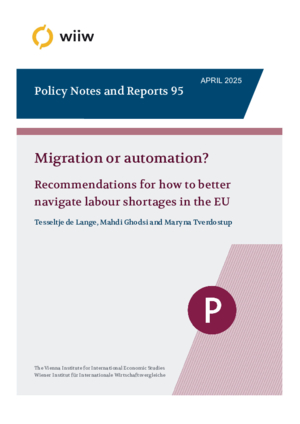Migration or automation? Recommendations for how to better navigate labour shortages in the EU
Tesseltje de Lange, Mahdi Ghodsi and Maryna Tverdostup
wiiw Policy Note/Policy Report No. 95, April 2025
19 pages including 2 Figures
This policy brief draws on the findings of Tverdostup et al. (2025) to examine Austrian firms’ responses to labour shortages through automation and migration. Like many European nations, Austria has been grappling with labour shortages over the past decade. These shortages have been influenced by demographic shifts, economic cycles and evolving industry demands. Understanding these trends is crucial for formulating effective policy responses, particularly in the realms of migration, education and automation, three policy domains central to our Horizon Europe project formulating a Global Strategy for Skills, Migration and Development (GS4S). The referenced empirical evidence indicates that automation largely complements human labour, notably benefiting low-educated migrants who are not from the European Economic Area (EEA), but posing challenges for highly educated migrant workers. Policy recommendations include improving EU migration policies, streamlining the recognition of qualifications, developing targeted training initiatives, and incentivising responsible automation practices to foster inclusive labour market growth and resilience.
Keywords: automation, labour migration, skills, labour shortages, substitution, EU
JEL classification: F22, O15, K37
Countries covered: Austria, European Union
Research Areas: Labour, Migration and Income Distribution
